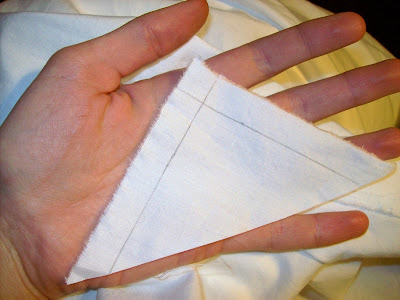Inserting gussets on a chemise

I'm currently making a 19th century chemise to use for reenacting. I just set gussets into it and want to show exactly how I did it for future reference and also to open discussion for different methods. Maybe there is a way that is easier or more effective. I welcome input! First, I cut these triangular gussets. They are four inches on each side. The lines mark the seam half an inch from each edge, wide enough to fell the seam to hide raw edges. Lines aren't necessary, but make it easier to align the gusset perfectly and also show exactly how I did this process. This is the slit into which I am inserting the gussets, cut along the grain. Notice how it is a cut slit, not an open seam. That made the process slightly more challenging since the raw edges of the slit were facing toward the gusset, in contrast to a seam, where there would be a folded edge facing the gusset. I set the gusset piece like so, right sides facing, and stitched



